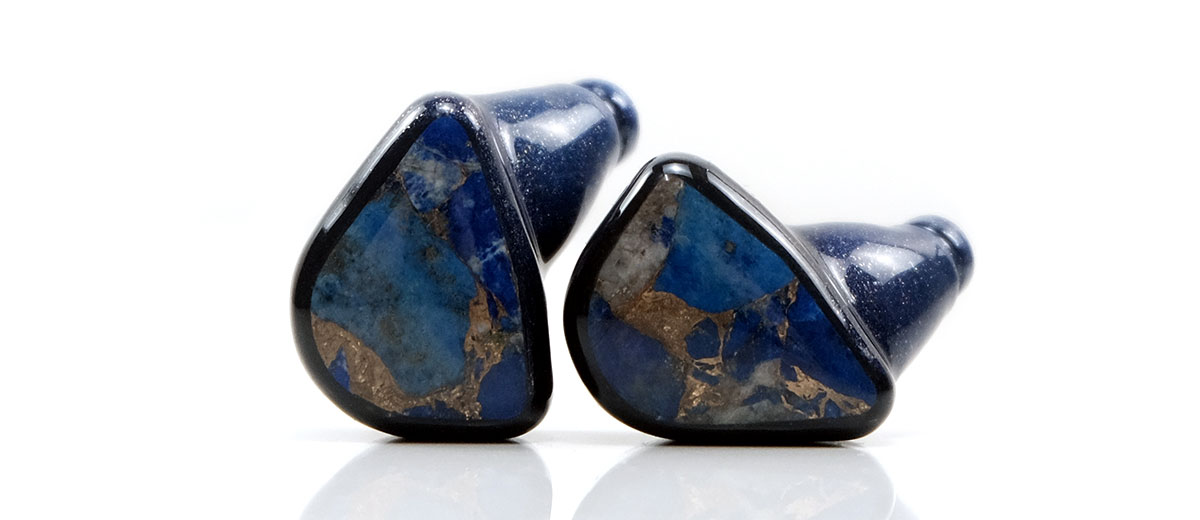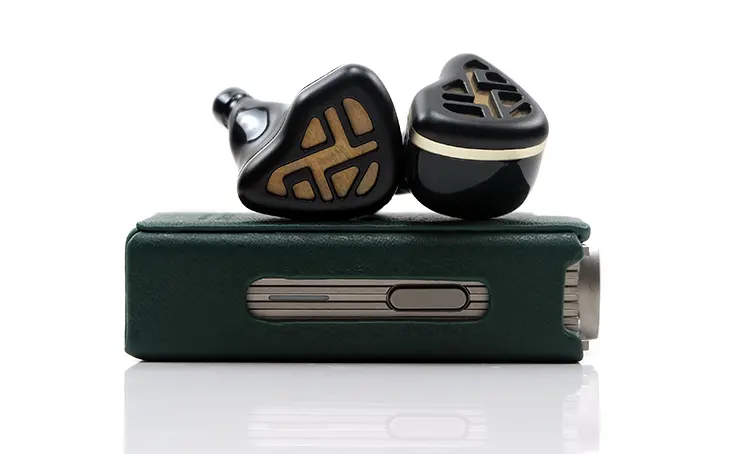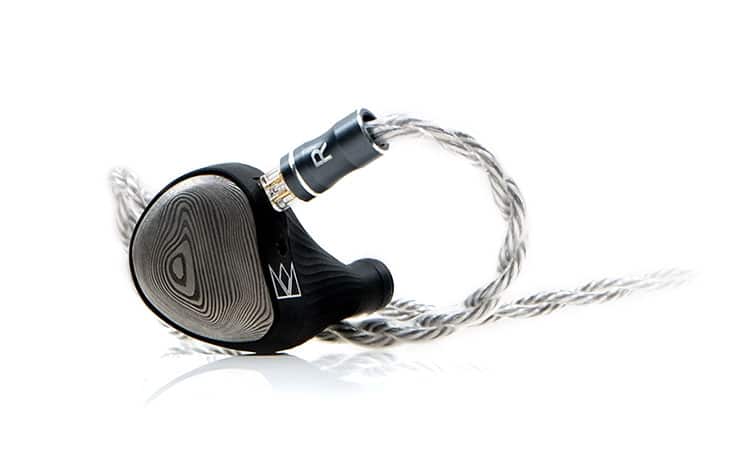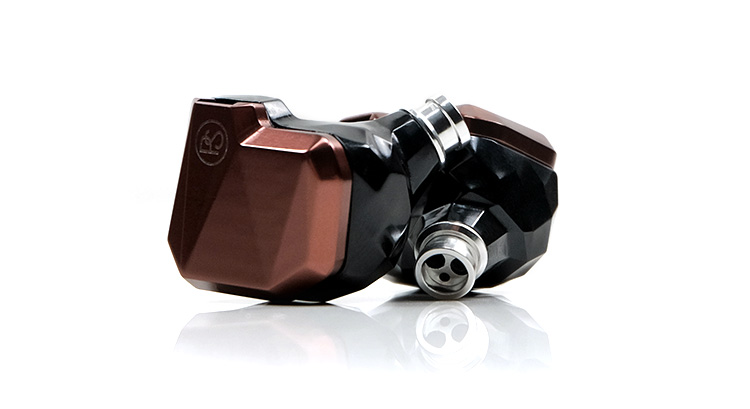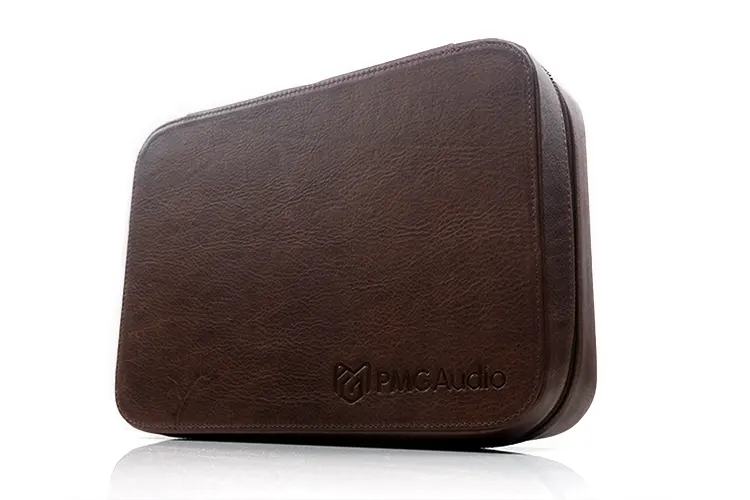Select Comparisons
The following comparisons to the PMG Audio Apx SE were completed using a mix of the iBasso DX320 MAX Ti and the ONIX Mystic XP1 with the stock cable and silicone tips.
Rossi&Wing First Light
The Rossi&Wing First Light is the debut high-end IEM from this Taiwanese boutique company with a base price point in the same bracket as the Apx SE.
Technical
The First Light is also a Tribrid driver universal monitor. It uses a 13-driver mix of dynamic, BA, and EST. However, the EST and dynamic merge into a unique component called an R-ESTDD (10mm Rear Electrostatic-dynamic driver).
The EST component focuses on the treble and mid-low regions, overlapping with the 6 dual BA drivers, and extending from the sub-bass to the upper treble, which assists the R-ESTDD with treble extension.
The Apx SE’s UPS round and rectangular planar frequency target starts below the dynamic driver on the sub-bass frequencies and then uses the smaller rounded planar for the ultra-highs. Its BA drivers are also dual-driver configurations and like the First light it focuses primarily on the mids and highs.
The First Light is rated at 13.5Ω impedance and has a sensitivity of 113 dB/mW @ 1 kHz, so it’s a slightly lighter load and more sensitive than the Apx SE. In truth, both are powerful enough to drive from a good source.
The Apx SE’s main advantage is FIBAE, which should provide more assurance of a flat impedance response. However, I have not yet found any impedance skew issues with the First Light pairings.
Design
They have very different design philosophies but the TLDR is I think First Light has a slight edge in the premium ‘look’ but the Apx SE is functionally more comfortable to wear with superior passive isolation.
First Light is a fatter heavier monitor making them more tip-centric for passive isolation performance and general comfort levels. The Apx SE slides in deeper and though tips play a big role I can feel them seal up my ear canal a lot better with silicone tips.
The aesthetics is where First Light does well though this is a personal preference. The First Light shell sample I have is the Special Edition with a dashing blend of black and gold trimming. There is a cheaper black and silver option and a more expensive silver/silver alternative.
The First Light 3D-printed resin shelling is contoured but not as much as the longer and curvier Ape SE. The mix of CNC-machined aluminum alloy, stainless steel, and brass materials accounts for much of that weight.
I do like the Stone Edition blue design on the Apx SE. The Lapis Lazuli-Brass hybrid stone and a hand-painted blue-gold housing are beautifully finished but I have yet to see a finish quite like the First Light faceplates.
The Apx SE stock cable isn’t as easy to handle as the Luminox Morningstar R2216 cable that comes with the First Light but it feels like it has a bigger AWG-rated grade of wire compared to the thinner 26AWG+25AWG 4-wire coaxial geometry inside the Rossi&Wing flagship cable.
Performance
Without a PEQ filter applied to the highs of the First Light, the Apx SE is a superior monitor technically and tonally.
With a PEQ 0.7 Q peaking filter of around 5 dB around 7k and a Q of 0.3, the First Light opens up a hell of a lot more with much-improved note definition and tonal contrast, producing a much more convincing performance. However, it’s still tonally quite different from the Apx SE and technically a bit behind.
So, what are the major differences? Well, the Apx SE has a lighter body to its note quality, still very natural to slightly sweet, and a nice treble overtone that creates plenty of sparkle and headroom. The emphasis here is excellent separation and air with a tonally agreeable character.
The First Light is not as airy, sounding darker and denser with less separation and a slightly rounded note quality.
It is marginally more intimate for vocal imaging, a bit deeper and fuller on the lows but the highs are comparatively non-existent. Without PEQ, the presentation sounds muffled compared to the Apx SE.
PEQ adds the definition to the mids and highs of the First Light, improving the layering and the perception of clarity and vibrancy. It is still not as airy or as extended but it creates the necessary contrast on midrange and treble instrument notes for the ear to pick up on.
There might be an argument that dynamic range favors the Apx SE also but some of that might be relative to the staging size and dimensions combined with that lack of air.
The First Light does have staging depth in its favor and notes are more saturated suiting some vocal styles but the better width and height and more precise imaging favor the Apx SE.
Noble Audio Viking Ragnar
The Noble Audio Viking Ragnar was released at the end of 2022 and won our Top Gear 2022 Awards for Best Universal IEM.
Technical
The Viking Ragnar is a flagship hybrid 10-driver universal in-ear monitor but instead of the Apx SE’s mix of planar, dynamic, and BA, it uses EST, BA, and dynamic.
That being said, the Ragnar also has a non-standard configuration of two 10mm dynamic drivers for the lows along with dual BAs for the mids, dual BAs for the mid-highs, and a quad electrostatic array for the highs. There is no mix of planar or dynamic for the Ragnar low-end.
The Viking Ragnar is rated at a reasonable 17Ω impedance and 112 dB/mW sensitivity but as with most electrostatic hybrids, they can suck up more power than the stats might suggest.
Indeed, the Ragnar is slightly quieter than the Apx SE on a low gain setting via the DX320 MAX Ti balanced output.
The Ragnar also does not have flat impedance technology similar to the Apx SE’s FIBAE. However, like First Light, I have yet to find a definite impedance skew with its driver configuration from the sources I normally use.
Design
I feel somehow PMG has taken a leaf out of the Noble Audio design language with both monitors finished with an elongated shell designed to maximize the long nozzle’s potential reach down your ear canal.
It is no surprise then that the passive isolation levels are the same if using the same tips. Both feel like they are achieving the same insertion depth with the only difference being the slightly large main shell of the Noble sticking out a little more and feeling heavier due to the more profuse mix of metals in its casting.
The segways nicely into the aesthetics and the Rangar is a looker though its rigidity and ribbed main shell finish mean it is not quite as comfortable as the Apx SE resin shell.
The Ragnar shells are cut from a single aluminum block and given a distinctive shape with a similarly long nozzle. It is finished in an anodized matte black coating which gives it more of a grippy finish compared to the Apx SE but you can feel that finish a bit more in your ear.
Ragnar’s silvery-patterned Damascus stainless-steel plate is stunning and unique. The wavy or watery pattern on its surface is caused by a layered mix of various VG steel types combined with alternative metal elements. It can never be duplicated.
I like Ragnar’s stock 4-wire graphene, monocrystalline silver, and copper-silver alloy Magnus cable. However, it’s a bit behind the exquisite appearance and modular jack functionality of the new Ape SE stock cable.
Performance
Always with the Ragnar, it is the big 5-10k rise and fall in the highs, which can be polarizing depending on how much treble you enjoy in your presentation.
Ranged against the Apx SE it’s a starker and slightly drier sound, creating a more neutral to bright tonal quality. It is wonderfully expansive and open-sounding but can fatigue.
The Apx SE sounds more liquid over the mids and highs, slightly richer and warmer in its timbre from a reduced treble tuning and elevated lows so it has a more balanced timbre for my tastes.
One thing the Ragnar has in its favor is good clarity and separation between the lows and mids with a higher 500Hz to 1k curve. However, the bass response up to 500Hz is significantly lower in elevation so it carries less warmth into the mids timbre than the Apx SE.
The PMG tuning has a bit more bloom through the lower mids so while the vocal timbre is firmer, and imaging is a bit closer from 2-4k it can sometimes feel that it is competing a bit with the bass volume.
Depth favors the Apx SE, it’s firm with instruments’ fundamental frequencies sounding planted and authoritative. The Ragnar has an excellent extension with a natural dynamic driver decay but is arguably the politer of the two low-ends.
Upper treble reach is technically a bit better on the Apx SE though you might think the Ragnar is more extended due to the stronger 7-8k peaking. Beyond 10k, the Apx SE is very good for headroom.
PLUSSOUND Allegro
A surprise launch from a company generally known for its excellent high-end audio cables, the limited-run Allegro debuted in early 2023 and is priced in the $3-4k bracket.
Technical
The PLUSSOUND Allegro is also a ‘tribrid’ universal monitor with 12 drivers per side as opposed to the Apx SE’s 11.
This is a mix of dynamic, balanced armature, and 2nd generation Sonion electrostatic drivers inserted into a 3D printed acoustic chamber with a low-profile ‘slit’ in the housing to manage the dynamic driver airflow.
There is no planar driver technology inside the Allegro, however, like the Apx SE it’s a tweaked set of lows with a Ragnar-like dual 10m dynamic driver for the lows.
It also has a dual BA driver implementation with 2 for the mid-lows, 2 for the mids, and 2 for the mid-highs. The final grouping is a quad-EST driver array, (complete with micro-energizer) for the highs and ultra-highs.
The Allegro impedance rating is typically low for these types of hybrids at 12Ω but it’s slightly more sensitive on paper than the Apx SE for SPL at 112 dB/mW @1kHz.
I say on paper because EST drivers tend to tax most volume levels and indeed that is the case here with the Apx SE subjectively more sensitive than the Allegro in real-world use with the ONIX Mystic XP1 in low gain mode.
Design
The Allegro is a beautifully looking ‘chunky monkey’. However, it is a case of style over comfort also as it is nowhere near as comfortable as the Apx SE in my ear even though the passive isolation capability is surprisingly close when using the same silicone ear tips.
The issue is the Allegro’s irregular shell shape which carries a lack of uniformity into my concha basin and hits the ridges of my ear at odd angles. This creates slightly uneven pressure points, particularly on the underside where the vertical pressure is at its strongest.
Its large form factor also means it sticks out a bit more though the insertion depth is just as good as the Apx SE with silicone tips.
The aesthetics are gorgeous though. The Allegro’s dark bronze polygonal faceplate and gloss black diamond pattern body look stunning, no two ways about it. In a way, the Apx SE is a complementary contrast with the warm copper of the Allegro offsetting the cooler tones of the Stone Edition shell.
Since PLUSSOUND is a boutique cable company it’s no surprise the Allegro comes with a top-notch stock cable, the Copper+. This is a 4-wire high-purity 24AWG gauge UP-OCC copper cable with a fairly complex coaxial geometry that creates a slightly stiff handling experience.
For handling, the Apx SE cable does a lot better even if I find it a heavier cable. It’s not as stiff which is the big weakness of the Copper+ build. Also, Copper+ lacks a module jack feature which is sort of a thing for cables in 2024. Sonically, Copper+ is an excellent copper cable though.
Performance
Of the three compared the Allegro comes the closest to the general aim in terms of tuning and emphasis. Like the Apx SE, it’s a little heavier on the bass, slightly euphonic through the mids but not overly shouty, and with decent extension in the highs.
Where it falls short is the timbre mix from the drivers, which I find less cohesive sounding compared to the smoother mix of the Apx SE setup.
In short, it does not sound as natural with a fairly warmish fulsome set of lows sitting alongside a leaner more brittle set of mids and highs. The Apx SE driver integration creates a nice harmonic balance throughout, with nothing out of whack from top to bottom.
There is less bass weight from the Allegro, maybe by around 4-5 dB below 80Hz though offset by a good mid-bass performance.
It also has a slightly stronger 1k presence than the Apx SE but without the necessary weight and warmth, it can sound off, and not quite right in weight and tone. I need the stock foam tips with the Allegro to correct it.
The Apx SE also sounds deeper and wider staging-wise. The enhanced sub-bass presence creates a bit more room but also a more evenly tuned 2-5k range doesn’t distract your ears too much from the bigger picture. Everything sounds consistent and where it should be placement-wise.
The Allegro is not as airy or grandiose in its imaging placement. The staging is more rounded but it does extremely well with instrumental placement and clarity. Particularly so in the lower-mids which manage to keep the presentation relatively powerful and clear from congestion at the same time.
My Verdict
If it were not for the original Apx, I would be calling the Apx SE the best high-end universal monitor for 2024. What we have here is the best choice of monitors for 2024.
I could roll out the “why not get both” girl meme but deep enough pockets for both are rare, especially for limited-run batches that sell out so quickly.
If you are in a very lucky position of being able to choose then the Apx SE is the safer bet. It’s a smoother and more powerful sound signature you can listen to for hours on almost any DAP or dongle without fatigue.
The fantastic detail is there and the huge soundstage is there also; it is just not as complex sounding as the original. There will be fans of both and after listening to each I can see why.
Shout out to PMG for the improved packaging experience also, something which I felt needed addressing with the original. Its presentation has more of a premium feel this time around.
Overall, the PMG Audio Apx Se is the Yin to the original’s Yang. It brings a more ‘modern’ but equally outstanding high-end monitor sound to the table. If you get a chance to hear it, even just for a few minutes, it’s a memorable experience.
PMG Audio Apx SE Technical Specifications
- 11 drivers: 1x Rectangular Planar, 1x 10mm DD, 8xBA, 1x Round Planar (all drivers are custom-built to PMG Audio’s spec)
- True 7-way passive crossover
- Impedance: 5Ω ±1Ω
- SPL: 107 dB @1kHz
- Frequency response: 3Hz-22kHz

